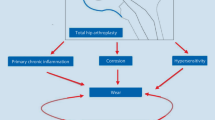Summary
In three patients a mechanically well-fixed Mathys Ceros 80 (Ha) hydroxyapatite-coated acetabular component was revised 2, 5 and 13 months after total hip replacement due to component malposition. In each case there was a thin cellular connective tissue membrane between hydroxyapatite and bone, the main cell type being fibroblast with only occasional giant cells. Immunohistological analysis revealed some MHC locus II antigen positive cells that were identified as monocytes. No interleukin-2 receptor positive cells were found. Under clinical cyclic loading conditions there does not seem to be chemical fixation or bony ingrowth into the hydroxyapatite coated prosthesis component. In human lymphocyte cultures, hydroxyapatite (Interpore 200, particle diameters 15–40 μm) did not cause an increase in lymphocyte DNA synthesis as assessed by the3H-thymidine incorporation method on culture days 1, 3 and 5. As analysed with lymphocyte activation markers, the hydroxyapatite-dependent expression of MHC locus II antigen was modest and differed significantly (P < 0.05) from that in culture medium only on day 3. Hydroxyapatite induced only a slight interleukin-2 receptor expression that did not differ from culture medium on days 1, 3 and 5. CD4 and CD8 positive lymphocytes as well as monocytes were not seen attached to hydroxyapatite particles during the culture days. Our findings suggest that hydroxyapatite is an immunologically inert implant material.
Similar content being viewed by others
References
Bucholz RW, Carlton A, Holmes RE (1987) Hydroxyapatite and tricalcium phosphate bone graft substitutes. Orthop Clin North Am 18:323–334
Charnley J (1961) Arthrosplasty of the hip: a new operation. Lancet I:1129
Charnley J (1970) The reaction of bone to self-curing acrylic cement: a long-term histological study in man. J Bone Joint Surg [Br] 52:340–353
Charnley J (1975) The histology of loosening between acrylic cement and bone. J Bone Joint Surg [Br] 57:245–258
Editorial (1990) Granulomatous reaction in total hip arthroplasty. Lancet 335:203–204
Geesink RGT, de Groot K, Klein CPAT (1988) Bonding of bone to apatite-coated implants. J Bone Joint Surg [Br] 70:17–21
Geesink RGT (1990) Hydroxyapatite-coated total hip prostheses: two-year clinical and roentgenographic results of 100 cases. Clin Orthop 261:39–58
Harris WH, Schiller AC, Scholler JM, Freiberg RA, Scott R (1976) Extensive localized bone resorption in the femur following total hip replacement. J Bone Joint Surg [Am] 37:612–617
Hayashi K, Uenoyama K, Matsuguchi S, Nakagawa S, Sugioka Y (1989) The affinity of bone to hydroxyapatite and alumina in experimentally induced osteoporosis. J Arthroplasty 4:257–262
Hoogendoorn HA, Renooij W, Akkermans LMA, Visser W, Wittebol P (1984) Long-term study of large ceramic implants (porous coated hydroxyapatite) in dog femora. Clin Orthop 187:281–288
Hsu S-M, Raine L, Fanger H (1981) Use of avidin-biotinperoxidase complex (ABC) in immunoperoxidase techniques: a comparison between ABC and unlabeled antibody (PAP) procedures. J Histochem Cytochem 29:577–580
Jarcho M (1981) Calcium phosphate ceramics as hard tissue prosthetics. Clin Orthop 157:259–278
Jones LC, Hungerford DS (1988) Cement disease. Clin Orthop 225:192–198
Konttinen YT, Segerberg-Konttinen M, Nordström D, Bergroth V, Scheinin T, Saari H (1988) An immunoperoxydase-autoradiography double labeling method for analysis of lymphocyte activation markers and DNA synthesis. J Immunol Methods 110:19–27
Linder L, Hansson H-A (1983) Ultrastructural aspects of the interface between bone and cement in man. Report of three cases. J Bone Joint Surg [Br] 65:646–649
Osborn JF (1987) Die biologische Leistung der Hydroxylapatitkeramik-Beschichtung auf dem Femurschaft einer Titanenprothese — erste histologische Auswertung eines Humanexplantats. Biomed Tech (Berlin) 32:7–8
Pazzaglia UE (1990) Pathology of the bone-cement interface in loosening of total hip replacement. Arch Orthop Trauma Surg 109:83–88
Santavirta S, Konttinen YT, Nordström D, Bergroth V, Antti-Poika A, Eskola A (1989) Immune-inflammatory response in infected arthroplasties. Acta Orthop Scand 60:116–118
Santavirta S, Konttinen YT, Saito T, Grönblad M, Partio E, Kemppinen P, Rokkanen P (1990) Immune response to polyglycolic acid biodegradable osteosynthese implants. J Bone Joint Surg [Br] 72:597–600
Santavirta S, Konttinen YT, Bergroth V, Eskola A, Tallroth K, Lindholm TS (1990) Aggressive granulomatous lesions associated with hip arthroplasty. Immunopathological studies. J Bone Joint Surg [Am] 72:252–257
Santavirta S, Hoikka V, Eskola A, Konttinen YT, Paavilainen T, Tallroth K (1990) Aggressive granulomatous lesions in cementless total hip arthroplasty. J Bone Joint Surg [Br] 72:980–984
Santavirta S, Konttinen YT, Hoikka V, Eskola A (1991) Immunopathological response in loosening of the cementless THR acetabular component. J Bone Joint Surg [Br] 73:38–42
Santavirta S, Konttinen YT, Bergroth V, Grönblad M (1991) Immune response to methylmethacrylate. Acta Orthop Scand 62:29–32
Stephenson PK, Freeman MAR, Rewell PA, Germain J, Tuke M, Pirie CJ (1991) The effect of hydroxyapatite coating on ingrowth of bone into cavities in an implant. J Arthroplasty 6:51–58
Tallroth K, Eskola A, Santavirta S, Konttinen YT, Lindholm TS (1989) Aggressive granulomatous lesions after hip arthroplasty. J Bone Joint Surg [Br] 71:571–575
Author information
Authors and Affiliations
Additional information
This work was financially supported by Grants from The Finnish Orthopedics and Traumatology Research Foundation, The Juliana von Wendt Foundation, The Paulo Foundation, The Perklén Foundation, and The Juselius Foundation
Rights and permissions
About this article
Cite this article
Santavirta, S., Nordström, D., Ylinen, P. et al. Biocompatibility of hydroxyapatite-coated hip prostheses. Arch Orthop Trauma Surg 110, 288–292 (1991). https://doi.org/10.1007/BF00443460
Issue Date:
DOI: https://doi.org/10.1007/BF00443460




